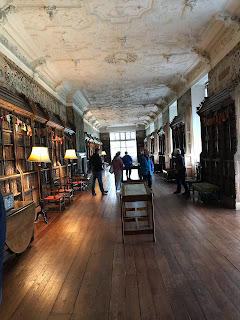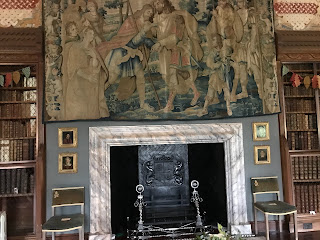On the third day in Norfolk the heavens opened and as a result every man and his dog—and us tagging along—decided to visit Blickling Hall, a magnificent house and most importantly dry. We decided to forgo a walk in its 5,000 acres of parkland in favour of the house and its remarkable history.
Built on the ruins of a much earlier building, the present house was designed by the Jacobean architect Robert Lyminge who, in the hope of a long life, I wouldn’t have asked to design a kennel.
His two most famous clients were Sir Henry Hobart who commissioned Blickling Hall, and Sir Robert Cecil, 1st Earl of Salisbury who had him design and build Hatfield House.
The unlucky Earl never got to live in his new home, dying of cancer in the spring of 1612. The house was only finished later that year.
Henry Hobart did at least get to live in Blickling Hall, but for less than a year, and he’s haunted the place ever since; his dying groans are still heard in the West Turret bedroom—usually on the anniversary of his death; getting value for money, I suppose. No, a long life for me; spare me the curse of Lyminge.
The main stairway from the hall. At the top, it branches out on to two landings, and two funky statues of Anne Boleyn and her daughter Elizabeth I, both women supposedly dancing. Anne grew up somewhere else, but she was reputedly born here.
The long gallery and library with its magnificent Jacobean ceiling, 12000 books, and refugees from the rain.
Halfway down the gallery, because it can get a bit chilly, a hearth but no fire
And at the far end of the gallery:
The State Chair that held the bottom of James II at the state opening of the Irish Parliament. We were not allowed to sit on it. I wasn't too impressed. It looks like something from a charity shop.
The Chinese Bedroom with its handprinted wallpaper showing scenes from Chinese life.
Blickling has other ghosts, too. Anne Boleyn’s great grandfather, Geoffrey Boleyn bought the original house from Sir John Falstaff, the knight that Shakespeare popularised as a drunken buffoon. The real Falstaff was a more substantial figure. Whatever the case, Falstaff clearly regretted the sale because he also haunts the place, probably lamenting what Robert Lyminge did to the old house.
Anne Boleyn too is a regular visitor, usually on the eve of her execution (May 19) Can’t miss the woman, dressed in white and carrying her dripping head on her lap—usually in a coach driven by a headless horseman and four headless horses. Talk about attention seeking, or maybe just revisiting the place of her birth and wondering where it all went wrong.
The portrait of the lady to left is that of a remarkable woman, Henrietta Countess of Suffolk. Henrietta exemplifies the indomitable spirit. Born in 1689, she lost her father in a duel when she was twelve, and her mother to illness. Faced with mounting debts, perhaps even having to sell the house she married Charles Howard the younger son of the Earl of Suffolk, who proved a drunk and abusive husband. Did that deter her? No. The story continues
To our relief the deluge enjoyed a short tea-break so we wandered outside—not far—the tea-break didn't last long and we scurried back inside—to one of the great second hand bookshops - more like a well equipped library.
We were put on to it in the gardens by two passing strangers. The husband carried a bag full of books, and it is my experience that book lovers enjoy a universal language and love to share their enjoyment. We began talking, and to our delight both had considered living in Monmouth, had family there, and enjoyed a curry in the Misbah, an old and established Indian restaurant in the town. We enjoyed their company, the book shop even more, where I bought a rare Anya Seton, Harrison Ainsworth's Old Saint Pauls AND . . . A BIGGLES BOOK! All for under a fiver. Thank you Blickling Hall.
The house from behind
















4 comments:
It staggers the imagination how much money these people had. That's probably why the ghosts stay on. They don't want to give up all their lucre.
Maria, you have seen nothing until you’ve seen Waddenham, the seat of the Rothschilds. Now that is a treasure house - coming up in two weeks time 😎
A beautiful story, Michael. Thank you for sharing... Im looking forward to your take on Waddenham... You know, in my opinion and for what it's worth, most people, have no mental measure of opulence unless we are born and raised in it... To wit: the Rothschilds, et al. I know I don't!!! I have a pea-brain when it comes to that... "Opulence suggests authority and wealth and, no doubt, sparked fantasy in the imagination!!!" Love your photos! ❤📸
Two fascinating Rothschilds coming up along with bags of opulence
Post a Comment